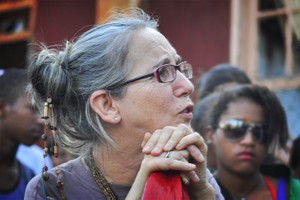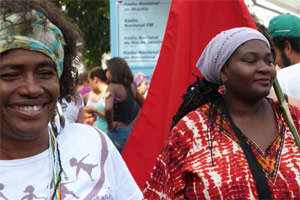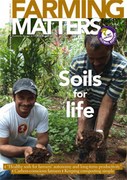“If you have a healthy, living soil, you have healthy plants and healthy people. These three things are closely linked.” Irene Cardoso, a professor of soil science at the Federal University of Viçosa and a member of ILEIA’s board is passionate about soils and family farmers. In her role as president of the Brazilian Agroecology Association, she advocates for greater support for family farmers to take better care of their soils. “Family farmers live from the soil, but they also live on the soil.”

What links family farmers and soils?
This depends on the type of agriculture you are looking at. In industrial agriculture, the soil is regarded as little more than a substrate to which fertilizer and seeds are added. In this type of agriculture, which requires expensive inputs and creates an unhealthy environment, family farmers may lose everything.
However, in sustainable agriculture or agroecology, the soil is very important. Good soil quality gives farmers autonomy, resilience and long-term productivity. This is why healthy soil is important for family farmers. But family farmers are also important for soils, because building and maintaining healthy soils requires work – exactly what family farmers do.
Many farmers all over the world tell me “the land has to function” and they know they have to make it function. As they work with nature all the time, they see the difference between living soil and degraded soil. They see that a plant growing in healthy soil does not need fertilizer. But very few of them use the word soil, and talk only about land. Why? ‘Soil’ is a more scientific word. The term ‘land’ implies a more integrated approach, referring to political and social debates around access, ownership and control. For example, farmers don’t ask for soil reform, but for land reform.
Family farmers live from the soil, but they also live on the soil. Their children will inherit the soil with the quality they leave it. The soil is almost part of the family. And you can hear farmers all over the world saying that “the land is our mother.” What is also important about family farmers, are the women. Women family farmers tend to have a stronger connection to the land, and a better awareness of the importance of food sovereignty and food security than men.
Can you give a good example of how farmers improved their soil?
“They wanted to repair their ‘poisoned’ land after decades of applying fertilizer and pesticides.”
In 1993, me and other people from the University of Viçosa worked with CTA, an NGO promoting agroecology in the Zona da Mata, in contacting the union of coffee farmers in the nearby town of Araponga. Using Participatory Rural Appraisal methods, we identified the main problems and needs. The farmers were clear that their biggest problem was poor soils: “The land is weak” they said. Technical staff already knew this, but the important thing was that farmers also recognised this explicitly.
We set up a committee called ‘Strong Land’, and farmers came up with some very effective solutions to increase soil organic matter, including green manure, cutting and not uprooting weeds. The technical staff proposed agroforestry systems (planting trees in and around their fields). And it worked. The soil, once recovered, became alive again, and the practices are spreading.
The success was helped by using participatory methods, discussing the problems and planning actions together with farmers. What also helped was working with their ideas. The only new practice we proposed was agroforestry, the rest they knew, or at least some of them remembered it from the past.
What makes this story so relevant?
Extension services and universities usually tell farmers to follow new, ‘modern’ techniques. What we see in our region though, is that farmers who want to follow another path can do so if they have the opportunity. We noticed that participation is important: the most experienced farmers sharing their knowledge with others and taking decisions together. This was significant in the historical context. The farmers wanted to use better farming practices to repair their ‘poisoned’ land after decades of applying excessive amounts of fertilizer and pesticides. Such practices were part of the Green Revolution technologies that started in Brazil during the 1964-84 dictatorship. The government supported these technologies with new policies, changing agricultural university curricula and reorganising extension services. As a consequence, university research and research-based extension promoted the use of pesticides, fertilizers, mechanisation, irrigation, and hybrid seeds that later developed into GMOs. All these supported monoculture production, further encouraged by the banks who offered farmers lowinterest credit for investing in these technologies.
How did the Brazilian agroecology movement start?
With the Green Revolution, production increased in some places, but not in others. And the rate of increase declined too, as the soil became degraded. Our agronomists said: “if you switch from food crops to producing monoculture coffee, you will earn more money to buy your food.” But what happened is that farmers got into debt and went bankrupt. Production of only one crop makes farmers entirely dependent on international commodity markets. Those farmers who switched to coffee could not afford to buy food when the price went down, and they no longer produced their own food. Small-scale farmers could not pay their debts, and many abandoned their farms and moved to the cities. And there were other consequences: land became poisoned, soils died, food and water quality deteriorated.
So these Green Revolution approaches went against food security and food sovereignty. Some farmers resisted this, however, and continued to farm the way they used to – at least on part of their land. This became a cultural resistance because it was about the way people live and about being respectful to the efforts and investments of their parents and grandparents. These few farmers kept the traditional knowledge about soil health alive, and this later fed a new way of thinking. With the re-democratisation of Brazil, we looked for better practices, and we turned to these farmers, with the unions, grass root organisations linked to churches and other groups, and we saw the start of the agroecology movement in Brazil.
Does Brazil’s national agroecology policy support soils sufficiently?

Our National Plan for Agroecology and Organic Production (PLANAPO), launched in 2012, supports family farmers and biodiversity. But the link with soils is only indirect, and this is a mistake in my view.
We are now discussing the second PLANAPO, and it is good that this is happening in the International Year of Soils, as the role of soils in agroecology should be highlighted, with explicit reference to what measures are needed for good quality soil. In that way, PLANAPO can raise awareness and support better practices. For example, we do not want heavy machines that damage soil structure but lighter machines, and PLANAPO can support the development of such technology, as well as launch a credit programme for soil conservation.
How does the global food system impact soils around the world?
There are many worldwide policies and practices that connect our soils, in good and bad ways. Our soils in Brazil are red and yellow because of the iron oxide they contain. As iron oxide locks up phosphorus, there is less of this available for plants. So we import thousands of tonnes of it, for example from Africa, and add it to our savannah soils to produce soya beans. The soya is then exported to Europe for livestock feed. But European soils do not contain high levels of iron oxide, so the excess phosphorus we originally imported from Africa is leached out and ends up polluting European soils and water. This is an example of how the nutrient cycle is not closed in the global food system, and this has severe impacts on soils worldwide.
In another perverse example, Brazil imports 92% of the potassium used in its agriculture, including for coffee production. But coffee bean skins contain a lot of potassium which could be a great ecological fertilizer if returned to the soil. What was happening in recent years was that foreign companies were buying coffee skins to produce ‘clean’ energy in Europe. The argument was that Brazilian farmers were polluting the environment as the skins were put into piles and left to rot. This is true, but there would have been another solution: to process the coffee locally and leave the skins on the land, so that Brazilian coffee skins could fertilize Brazilian soils.
How can we change power imbalances between farmers and big business?
In the name of productivity, policy makers are protecting the sectors that produce the most. There are few possibilities to question this. This will change, but only with time. Private companies are not more important than citizens. We have to start a new cycle of development, based on deepened democracy and participation, which looks beyond elections every four years. It is a long process, but there is no other way. And we are already seeing some changes, in empowered farmers, in some companies being open to discussion, and in progressive individuals within certain companies.
So what is your message for the IYS?
Everybody wants to see healthy soils, but few want to talk about what degrades the soil in the first place. And we have to do so in order to change things. The real cause of the problem is the way we have been treating soil as a mere ‘container’ to add fertilizer, pesticides and GMO seeds.
We must understand that the soil has to be kept alive, whereas pesticides kill soil life. When you think of it, soil life needs the same as a human being: a house (a good soil structure so that organisms can live there), a clean environment (no chemicals), water (but not too much), air and food. To get these conditions, farmers have to work with biodiversity, there is no other way. And a healthy soil has lots of life, each organism doing its own job. Some of them fix nitrogen, others decompose, some aerate, and so on. So we must take care of our networks, above ground and below ground.
For example, I call mycorrhiza, which are soil fungi, the Facebook of the soil. They have the information about the soil and they are constantly engaged in exchanges with plant roots. We need to support these networks and use organic matter, no poison, and little or no tillage. Heavy tillage and heavy machinery destroy soil structure, destroy the house of the soil organisms. And even if chemical fertilizers are used, organic matter is needed. But with good soil quality and enough organic matter, you can decrease or stop using chemical fertilizers. If we feed the soil, we can feed the world.”
Interview: Janneke Bruil

